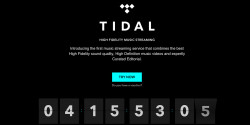Rapper and entrepreneur Jay-Z is throwing his hat into the streaming music arena with his acquisition last week of the Swedish company Aspiro and its two music services WiMP and TIDAL. WiMP is a Spotify competitor only available in Scandinavia, Germany and Poland. TIDAL is a CD-quality lossless service available in 31 countries world-wide, including the US. Perhaps because WiMP is kind of a wimpy name–at least in English–this week Jay-Z’s S. Carter Enterprises has decided to combine both services under the TIDAL name.
The new company is gearing up for a March 30 relaunch in the US at an event in New York City. The new TIDAL is expected to include both the currently available lossless service as well as the compressed service previously offered under the WiMP brand.
Already TIDAL has wooed Taylor Swift to bring her entire catalog on board, just months after she famously pulled her albums from Spotify. Jay-Z is also reportedly in talks with Madonna and other well-known artists to make their own, potentially exclusive, deals with TIDAL. On offer are ostensibly better deals with more artist control than those offered by Spotify and other competitors.
A number of prominent musicians, like David Byrne and indie rock veteran David Lowery, have spoken out critically about the low royalty payments they get from music streaming services like Spotify. At the same time other artists, like the equally-indie British punk rocker Billy Bragg and post-punker Dave Allen, place the blame on the recording industry. Bragg argues that the labels keep artists under “analog age” contracts that are premised on recovering costs associated with manufacturing and distributing physical CDs and records–costs that don’t exist with streaming and digital sales. Given that last year streaming music revenues surpassed CD sales, it seems like Bragg may have a point.
If TIDAL is going to offer better terms to artists than its competitors it would seem that record labels are a significant road block. It makes sense, then, that the company would start with big artists like Madonna, who are currently independent, or others who wield a lot of power, like Taylor Swift. The big question is if and how TIDAL can offer better terms to artists who are signed to labels but who lack the clout of multi-platinum sales. That question, of course, assumes that TIDAL intends to offer better deals to more than just a small stable of prestige artists.
On the lossless, CD-quality streaming front, TIDAL’s only other competitor in the US is Deezer Elite, which is only available on Sonos wireless audio systems. TIDAL is not tied to any specific hardware, and is available on mobile apps, a desktop app, a web browser player and an array of home audio systems, including Sonos. Because of differences in browsers and OS versions, full lossless quality is not available on every device or browser. As of last fall TIDAL claimed 17,000 users. Deezer, which recently expanded its Elite service to UK Sonos owners, has not released any figures on how many Elite subscribers there are.
I reviewed Deezer Elite last fall and recently tried out TIDAL’s lossless service for a review that I’m publishing in a companion post. TIDAL sounds as good as Deezer Elite when listening to the service on my Sonos Connect using the same receiver and speakers I used to test Deezer.
TIDAL’s obvious advantage is that it works across a much wider range of equipment. However, not every playback device takes equal advantage of TIDAL’s additional fidelity. In particular, mobile devices connected to the included earbuds will be hampered. My recent experience testing TIDAL bore that out. Read my full review for more impressions of TIDAL.
The ability to use TIDAL on other, possibly higher quality and more expensive equipment than Sonos does give the service a clear edge and opens it up to more potential users. That said, because the number of users with high quality stereos is a much more limited market, I’m betting that TIDAL will also offer up a lossy MP3-based service based on the WiMP library to the US and other countries.
One perspective is that the entry of one more full-service streaming music service is a good thing, because it brings more competition to help loosen Spotify’s hegemony. Yet, competition on price alone risks putting further competition on labels, and especially, artists. It will be interesting to learn next week how Jay-Z intends to position and sell TIDAL to a nation of users accustomed to getting their Spotify for free.



